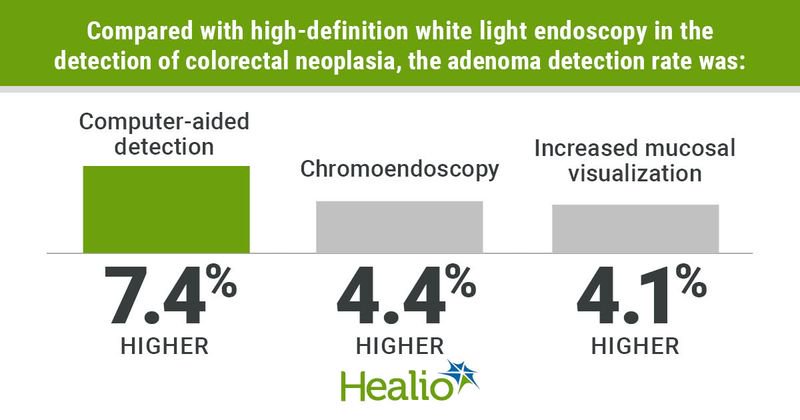AI bests chromoendoscopy, mucosal visualization in colorectal neoplasia detection
Detection rates for colorectal neoplasia were higher among computer-aided detection techniques vs. chromoendoscopy, according to research published in the Lancet Gastroenterology and Hepatology.
“Novel systems based on AI algorithms, also known as computer-aided detection (CADe) tools, have recently been developed, with the aim of improving the detection of colorectal neoplasia. ... Unlike other advanced endoscopy imaging technologies, CADe fully automates the process of facilitating detection as the endoscopist passively receives the signal to inspect a suspicious area without the need for active identification of the contrast between neoplastic and healthy tissue,” Marco Spadaccini, MD, Humanitas University, Pieve Emanuele, and colleagues wrote. “No randomized trials have directly compared CADe with other advanced endoscopy imaging techniques.”

In a systematic review and network meta-analysis, researchers aimed to investigate the effectiveness of various colorectal neoplasia detection techniques. Among 50 randomized controlled trials, they compared CADe (n = 6), chromoendoscopy (n = 18) and increased mucosal visualization systems (n = 26). High-definition white light endoscopy served as the control technique in all studies. Studied endpoints included adenoma detection rate, sessile serrated lesion detection rate, proportion of large adenomas detected per colonoscopy and mean difference for withdrawal time.
Compared with the control technique, the adenoma detection rate was 7.4% (OR = 1.78; 95% CI, 1.44-2.18) higher for CADe, 4.4% (OR = 1.22; 95% CI, 1.08-1.39) higher for chromoendoscopy and 4.1% (OR 1.16; 95% CI, 1.04-1.28) higher for increased mucosal visualization systems. Further, cross-comparisons yielded an increase in the adenoma detection rate with CADe vs. increased mucosal visualization systems (OR = 1.54; 95% CI, 1.22-1.94) and with CADe vs. chromoendoscopy (OR = 1.45; 95% CI, 1.14-1.85). CADe also ranked as the superior strategy for the detection of large adenomas (OR = 1.69; 95% CI, 1.1-2.6) as well as for the detection of sessile serrated lesions (OR = 1.37; 95% CI, 0.65-2.88). Researchers noted no significant difference in withdrawal time among each detection strategy.
“Based on the published literature, CADe seems to have an advantage over other advanced endoscopy imaging techniques, such as chromoendoscopy or mucosal visualization tools, for increasing the detection of colorectal neoplasia, which supports wider incorporation of CADe technologies into community endoscopy services,” Spadaccini and colleagues concluded.
